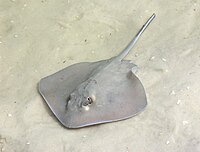
Photo from wikipedia
Abstract The present study was aiming at describing the feeding ethology and assessing surface sediment reworking together with associated effects on sediment characteristics and aerobic bacterial community composition by the… Click to show full abstract
Abstract The present study was aiming at describing the feeding ethology and assessing surface sediment reworking together with associated effects on sediment characteristics and aerobic bacterial community composition by the ampharetid polychaete Melinna palmata, which exhibits very dense populations in the Arcachon Bay (French Atlantic coast). There was a plasticity in the main aspects (i.e., positioning of the tube at the sediment-water interface, stretching of the worms outside their tubes while feeding, location and mechanism of faeces production) constitutive of the current knowledge regarding feeding ethology in ampharetids. On average, worms dedicated 84.6% of their time to the prospection of surface sediments and produced faeces exclusively at the water sediment interface, which resulted in surface sediment reworking and induced the zonation of surface sediment in three distinct areas, namely: undisturbed sediment, prospected and faecal mound areas. Average individual surface prospected area and surface sediment reworking rate were 28 cm2 and 6.8 mm3.h−1, respectively. Surface sediments were coarser and their bulk organic contents were lower in prospected areas, intermediate in faecal mound areas and higher in undisturbed sediments. Oxygen penetrated deeper in the sediment column in faecal mound areas. Aerobic bacterial community composition associated with surface oxygenated sediments within these three areas also significantly differed, which suggests that sediment reworking per se (i.e., irrespective of changes in redox conditions) do have an effect on those compositions. These results are discussed in terms of potential food limitation in the very dense populations of M. palmata present in the Arcachon Bay. It is suggested that the high densities of these populations result from both hydrosedimentary fluxes due to tidal currents and from the enhancement of particle sedimentation in Zostera noltei meadows.
Journal Title: Journal of Experimental Marine Biology and Ecology
Year Published: 2019
Link to full text (if available)
Share on Social Media: Sign Up to like & get
recommendations!